Electrical Energy Management Based on a Hybrid Artificial Neural Network-Particle Swarm Optimization-Integrated Two-Stage Non-Intrusive Load Monitoring Process in Smart Homes
Abstract
:1. Introduction
- The HEMS was constructed, conducted, and used as a benchmark to intrusively acquire electrical power consumption on monitored individual electrical appliances through ZigBee.
- The novel hybrid ANN-PSO-integrated NILM approach was used in the HEMS as a benchmark, to non-intrusively identify uses of electrical appliances consuming electrical energy. The methodology that automatically designs an ANN (feed-forward ANN) based on bio-inspired meta-heuristics (PSO) was proposed for load classification in NILM. In this case, the goal of PSO combined with feed-forward ANN was to simultaneously evolve the network architecture determined for load classification, the type of activation functions used by artificial neurons, and the set of synaptic weights/weighting connections including biases. In the PSO method used in this paper, the three aforementioned principal design factors relating to an ANN design were codified into individuals that represent candidate solutions of an ANN to be evolved with a declared fitness function. In addition, the ANN designed by the proposed methodology was compared with a commonly used BP-ANN trained through the well-known Gradient Descent (GD) process.
- The HEMS with the novel hybrid ANN-PSO-integrated NILM was deployed and experimentally validated in a realistic house environment. The experimentation reported in this paper showed that the HEMS utilizing the proposed methodology to design an ANN for load identification in NILM gave an overall classification rate of 91.67%. The overall classification rate was improved by 8.34% with the use of the proposed methodology.
2. Methodology
2.1. IoT-Orientied HEMS with ZigBee Wireless Communications
2.2. NILM Based on an Innovative Hybrid ANN-PSO-Integraed Approach to Model and Identify Electrical Household Appliances Consuming Electrical Energy
2.2.1. ANN
2.2.2. PSO
2.2.3. Novel Hybrid ANN-PSO Optimizing the Three Principal Design Factors Relating to an ANN Design
3. Experimentation
4. Conclusions and Future Work
Author Contributions
Funding
Acknowledgments
Conflicts of Interest
References
- Tsai, M.S.; Lin, Y.H. Modern development of an adaptive non-intrusive appliance load monitoring system in electricity energy conservation. Appl. Energy 2012, 96, 55–73. [Google Scholar] [CrossRef]
- Dong, M.; Meira, P.C.M.; Wilsun, X.; Freitas, W. An event window based load monitoring technique for smart meters. IEEE Trans. Smart Grid 2012, 3, 787–796. [Google Scholar] [CrossRef]
- Chang, H.H.; Lin, C.L.; Yang, H.T. Load recognition for different loads with the same real power and reactive power in a non-intrusive load-monitoring system. In Proceedings of the 12th International Conference on Computer Supported Cooperative Work in Design, Xi’an, China, 16–18 April 2008; pp. 1122–1127. [Google Scholar]
- Chang, H.H.; Lin, L.S.; Chen, N.M.; Lee, W.J. Particle swarm optimization based non-intrusive demand monitoring and load identification in smart meters. In Proceedings of the 2012 IEEE Industry Applications Society Annual Meeting (IAS), Las Vegas, NV, USA, 7–11 October 2012; pp. 1–8. [Google Scholar]
- Chang, H.H.; Lin, L.S.; Chen, N.M.; Lee, W.J. Particle swarm optimization based non-intrusive demand monitoring and load identification in smart meters. IEEE Trans. Ind. Appl. 2013, 49, 2229–2236. [Google Scholar] [CrossRef]
- Yang, H.T.; Chang, H.H.; Lin, C.L. Design a neural network for features selection in non-intrusive monitoring of industrial electrical loads. In Proceedings of the 11th International Conference on Computer Supported Cooperative Work in Design, Melbourne, VIC, Australia, 26–28 April 2007; pp. 1022–1027. [Google Scholar]
- Chang, H.H.; Lin, C.L.; Weng, L.S. Application of artificial intelligence and non-intrusive energy-managing system to economic dispatch strategy for cogeneration system and utility. In Proceedings of the 13th International Conference on Computer Supported Cooperative Work in Design, Santiago, Chile, 22–24 April 2009; pp. 740–745. [Google Scholar]
- Chang, H.H. Non-intrusive demand monitoring and load identification for energy management systems based on transient feature analyses. Energies 2012, 5, 4569–4589. [Google Scholar] [CrossRef]
- Chang, H.H.; Chen, K.L.; Tsai, Y.P.; Lee, W.J. A new measurement method for power signatures of non-intrusive demand monitoring and load identification. IEEE Trans. Ind. Appl. 2012, 48, 764–771. [Google Scholar] [CrossRef]
- Amini, M.H.; Nabi, B.; Haghifam, M.R. Load management using multi-agent systems in smart distribution network. In Proceedings of the 2013 IEEE Power & Energy Society General Meeting, Vancouver, BC, Canada, 21–25 July 2013; pp. 1–5. [Google Scholar]
- Bahrami, S.; Wong, V.W.S. An autonomous demand response program in smart grid with foresighted users. In Proceedings of the 2015 IEEE International Conference on Smart Grid Communications (SmartGridComm), Miami, FL, USA, 2–5 November 2015; pp. 205–210. [Google Scholar]
- R: The R Project for Statistical Computing. Available online: https://www.r-project.org/ (accessed on 13 September 2018).
- Ramya, C.M.; Shanmugaraj, M.; Prabakaran, R. Study on ZigBee technology. In Proceedings of the 3rd International Conference on Electronics Computer Technology (ICECT), Kanyakumari, India, 8–10 April 2011; pp. 297–301. [Google Scholar]
- Qivicon Smart Home Alliance. Available online: https://www.qivicon.com (accessed on 25 July 2018).
- Gao, L.; Wang, Z.; Zhou, J.; Zhang, C. Design of smart home system based on ZigBee technology and R&D for application. Energy Power Eng. 2016, 8, 13–22. [Google Scholar] [CrossRef]
- Froiz-Míguez, I.; Fernández-Caramés, T.M.; Fraga-Lamas, P.; Castedo, L. Design, implementation and practical evaluation of an IoT home automation system for fog computing applications based on MQTT and ZigBee-WiFi sensor nodes. Sensors 2018, 18, 2660. [Google Scholar] [CrossRef] [PubMed]
- Ullah, I.; Kim, D. An optimization scheme for water pump Control in smart fish farm with efficient energy consumption. Processes 2018, 6, 65. [Google Scholar] [CrossRef]
- Lin, Y.H.; Hu, Y.C. Residential consumer-centric demand-side management based on energy disaggregation-piloting constrained swarm intelligence: towards edge computing. Sensors 2018, 18, 1365. [Google Scholar] [CrossRef] [PubMed]
- Pedersen, M.E.H.; Chipperfield, A.J. Simplifying particle swarm optimization. Appl. Soft. Comput. 2010, 10, 618–628. [Google Scholar] [CrossRef]
- Karakis, R.; Tez, M.; Kılıç, Y.A.; Kuru, Y.; Güler, İ. A genetic algorithm model based on artificial neural network for prediction of the axillary lymph node status in breast cancer. Eng. Appl. Artif. Intell. 2013, 26, 945–950. [Google Scholar] [CrossRef]
- Kennedy, J.; Eberhart, R. Particle Swarm Optimization. In Proceedings of the ICNN’95—International Conference on Neural Networks, Perth, WA, Australia, 27 November–1 December 1995; pp. 1942–1948. [Google Scholar]
- Alex Pandian, S.I.; Bala, G.J.; Anitha, J. A pattern based PSO approach for block matching in motion estimation. Eng. Appl. Artif. Intell. 2013, 26, 1811–1817. [Google Scholar] [CrossRef]
- Parsopoulos, K.E.; Vrahatis, M.N. Recent approaches to global optimization problems through Particle Swarm Optimization. Nat. Comput. 2002, 1, 235–306. [Google Scholar] [CrossRef]
- Wang, B.; Sun, Y.; Xue, B.; Zhang, M. Evolving deep convolutional neural networks by variable-length particle swarm optimization for image classification. In Proceedings of the 2018 IEEE Congress on Evolutionary Computation (CEC), Rio de Janeiro, Brazil, 8–13 July 2018; pp. 1–8. [Google Scholar]
- Du, L.; Restrepo, J.A.; Yang, Y.; Harley, R.G.; Habetler, T.G. Nonintrusive, self-organizing, and probabilistic classification and identification of plugged-in electric loads. IEEE Trans. Smart Grid 2013, 4, 1371–1380. [Google Scholar] [CrossRef]
- Lin, Y.H.; Hung, S.K.; Tsai, M.S. Study on the influence of voltage variations for non-intrusive load identifications. In Proceedings of the 8th International Power Electronics Conference (IPEC-Niigata 2018-ECCE Asia), Niigata, Japan, 20–24 May 2018; pp. 1575–1579. [Google Scholar]
- Salman, I.; Ucan, O.N.; Bayat, O.; Shaker, K. Impact of metaheuristic iteration on artificial neural network structure in medical data. Processes 2018, 6, 57. [Google Scholar] [CrossRef]
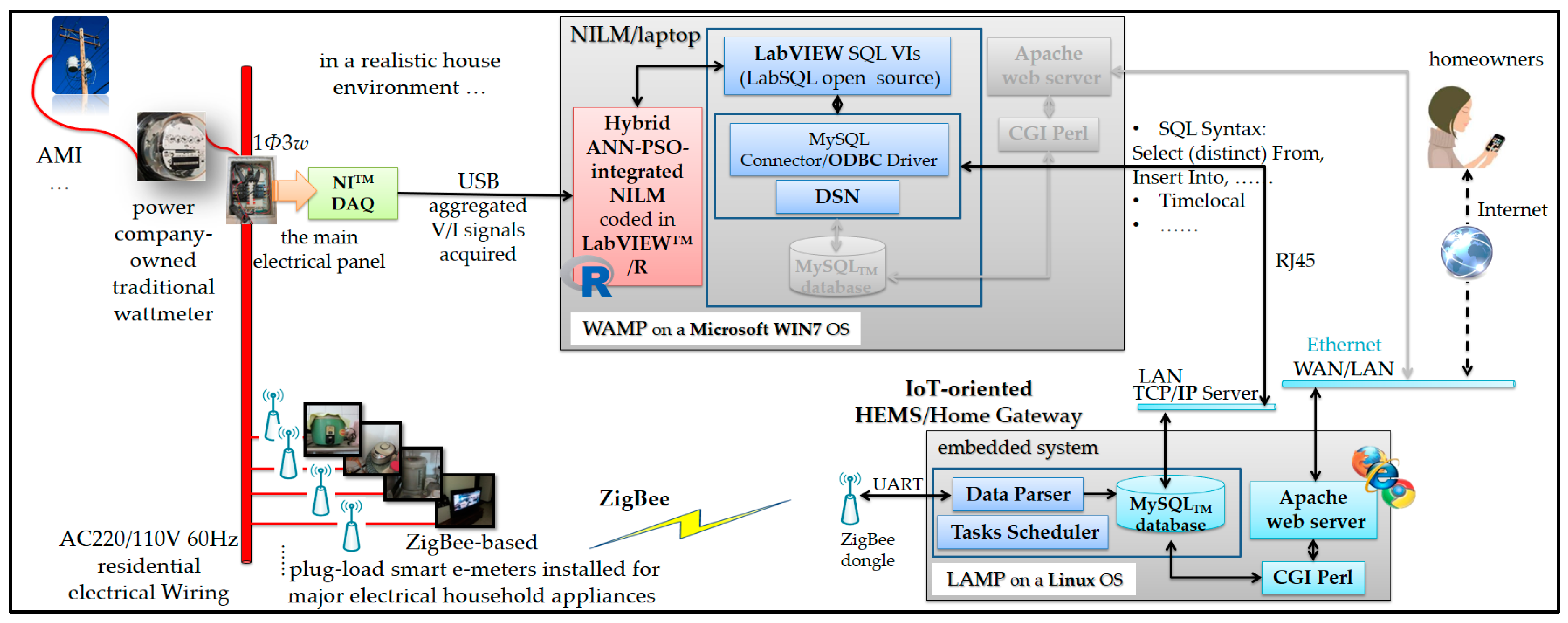
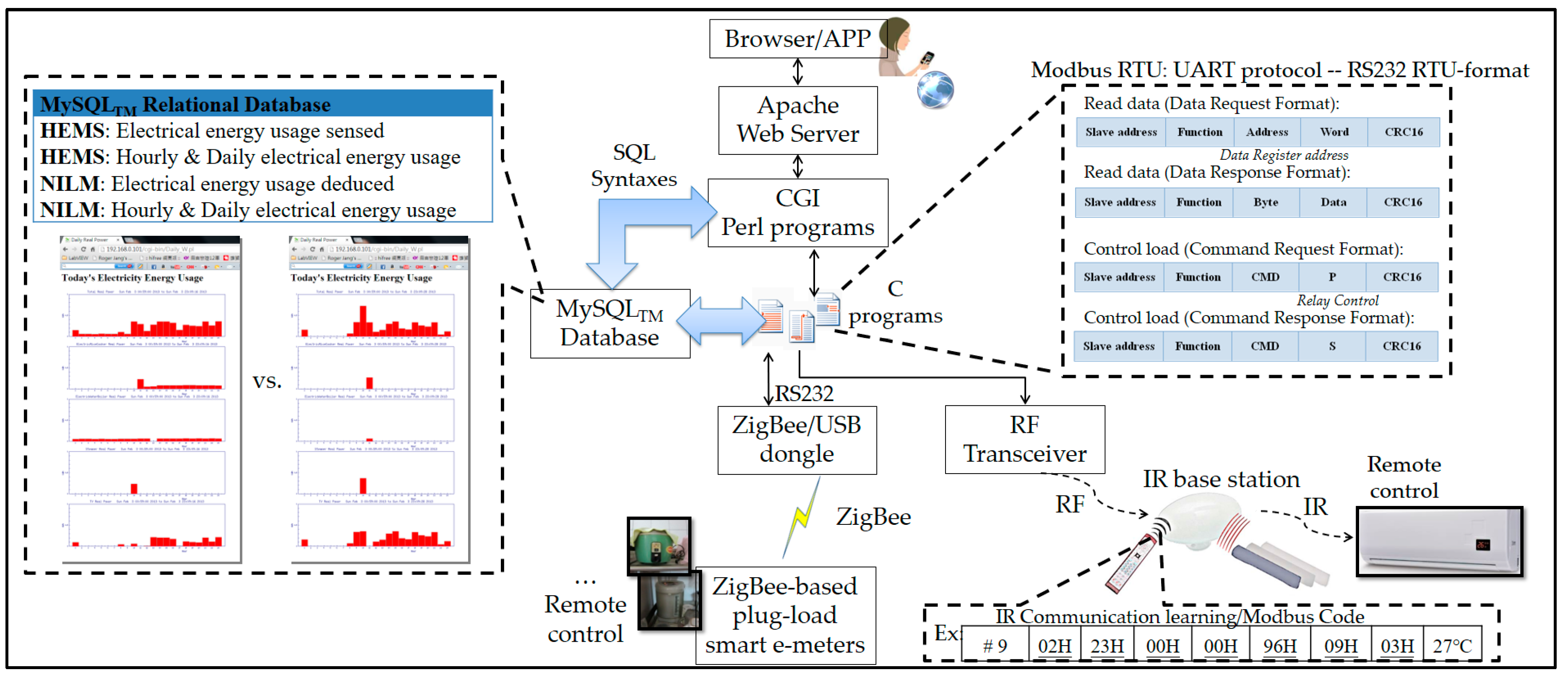
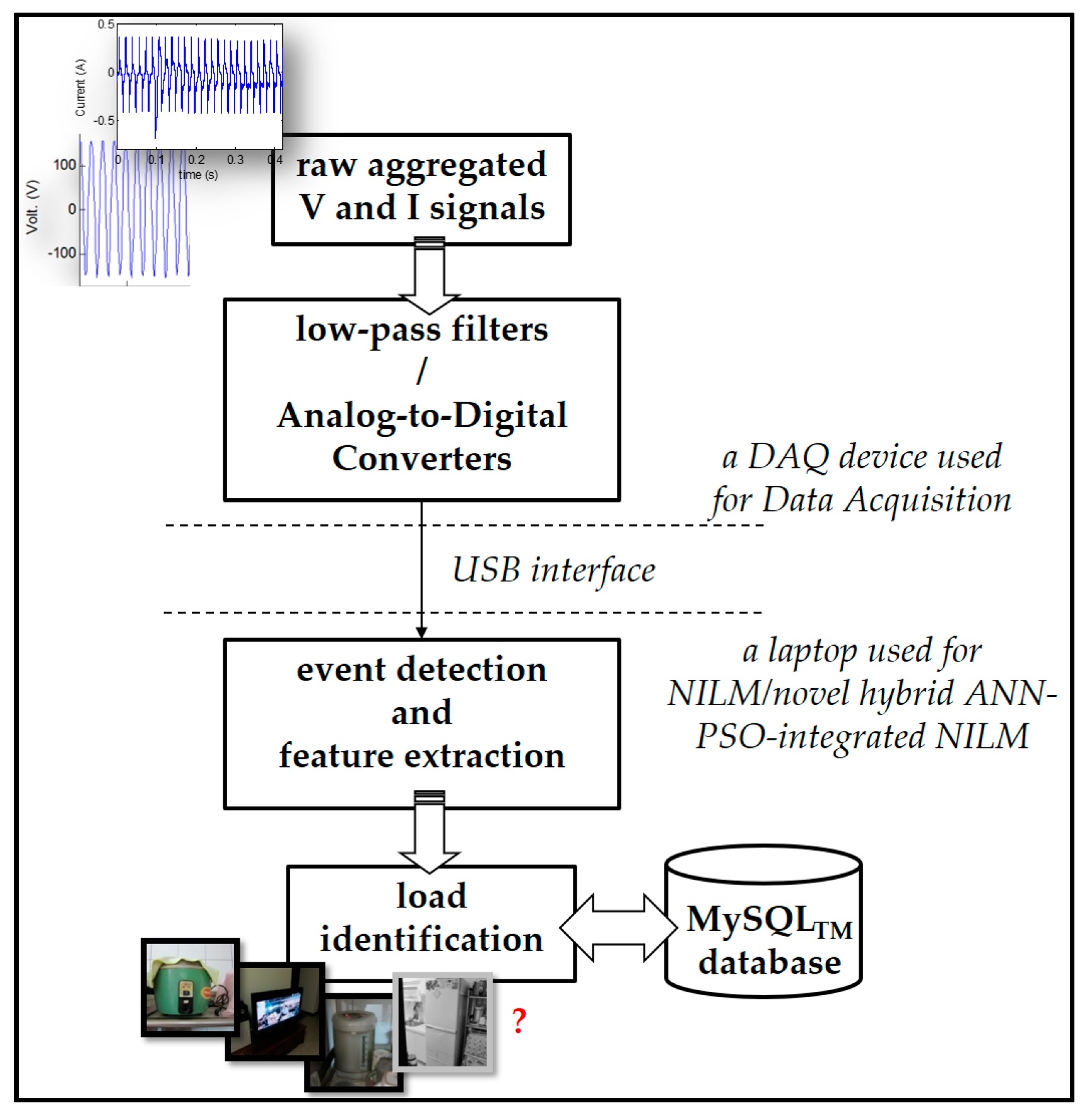
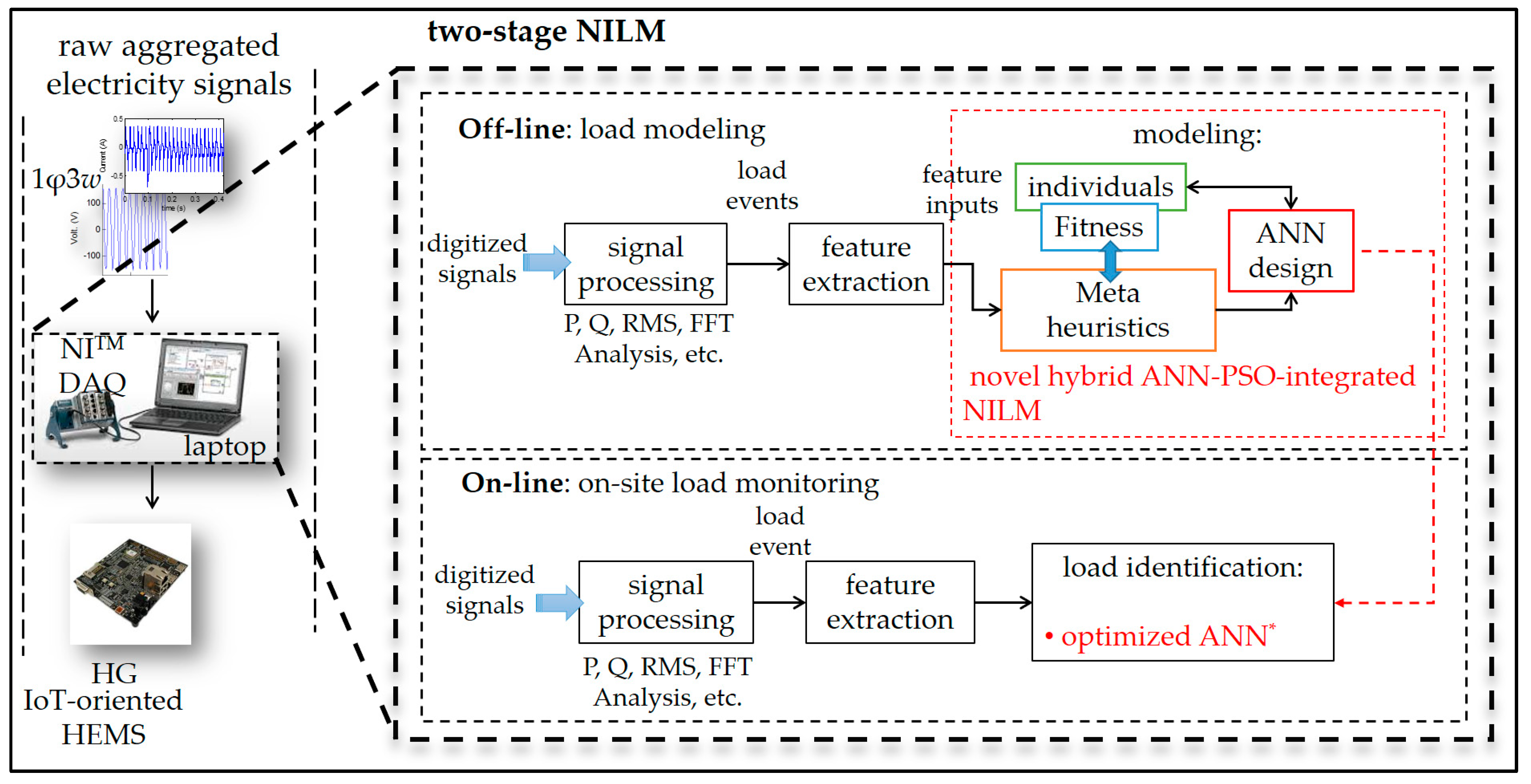
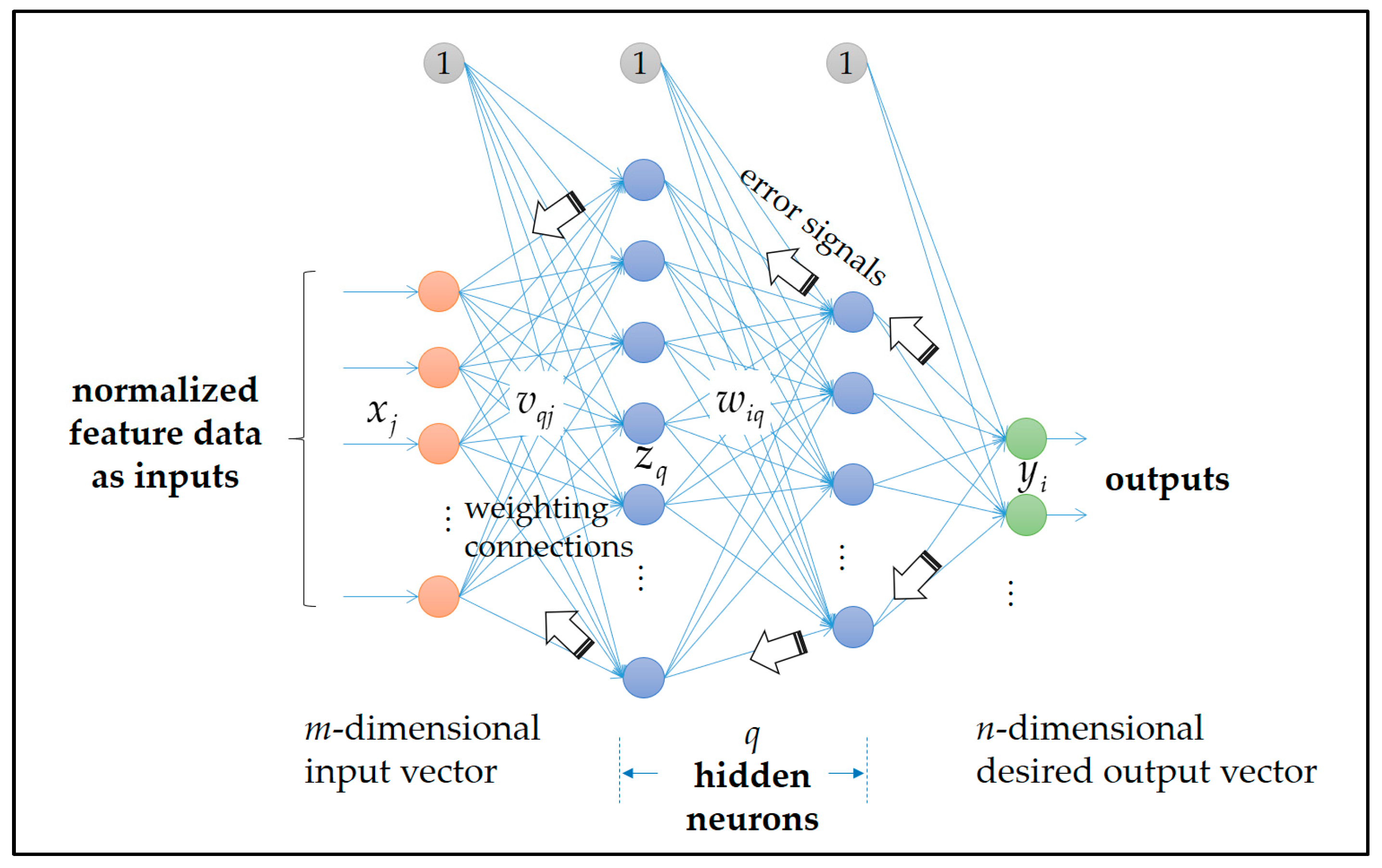
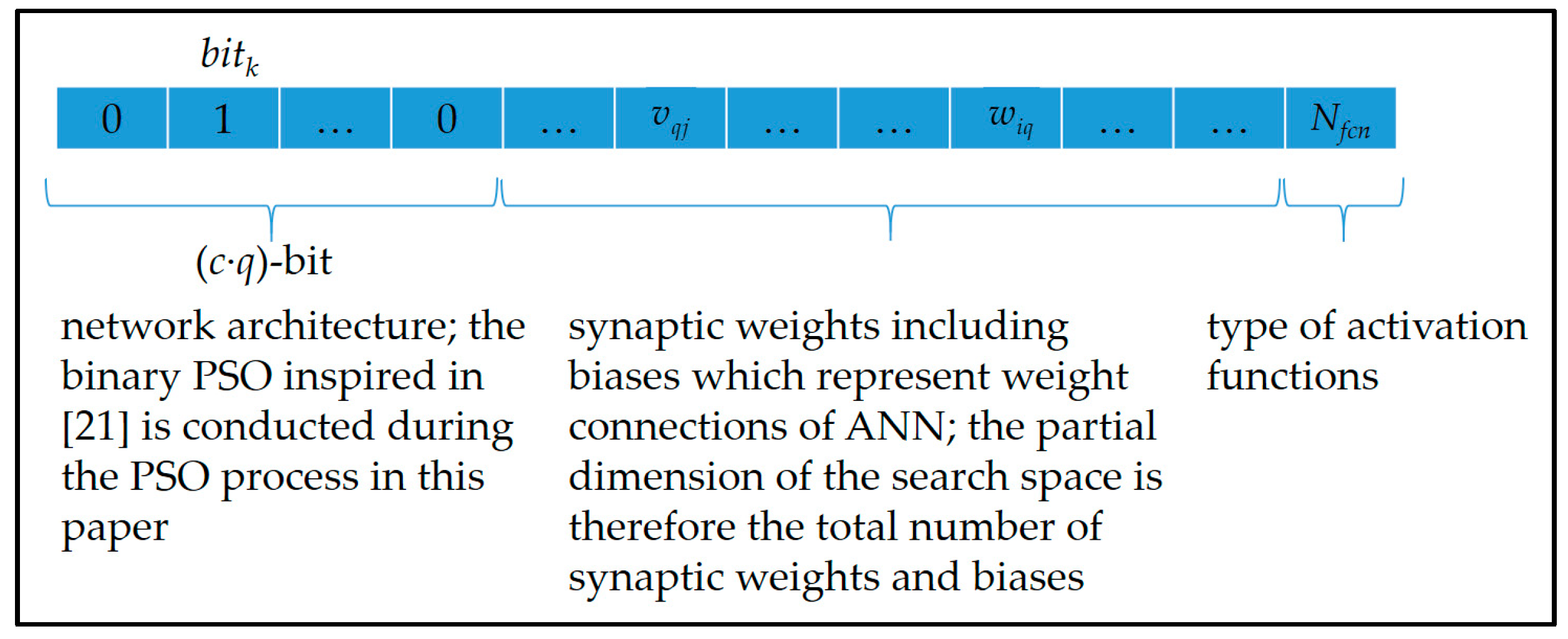
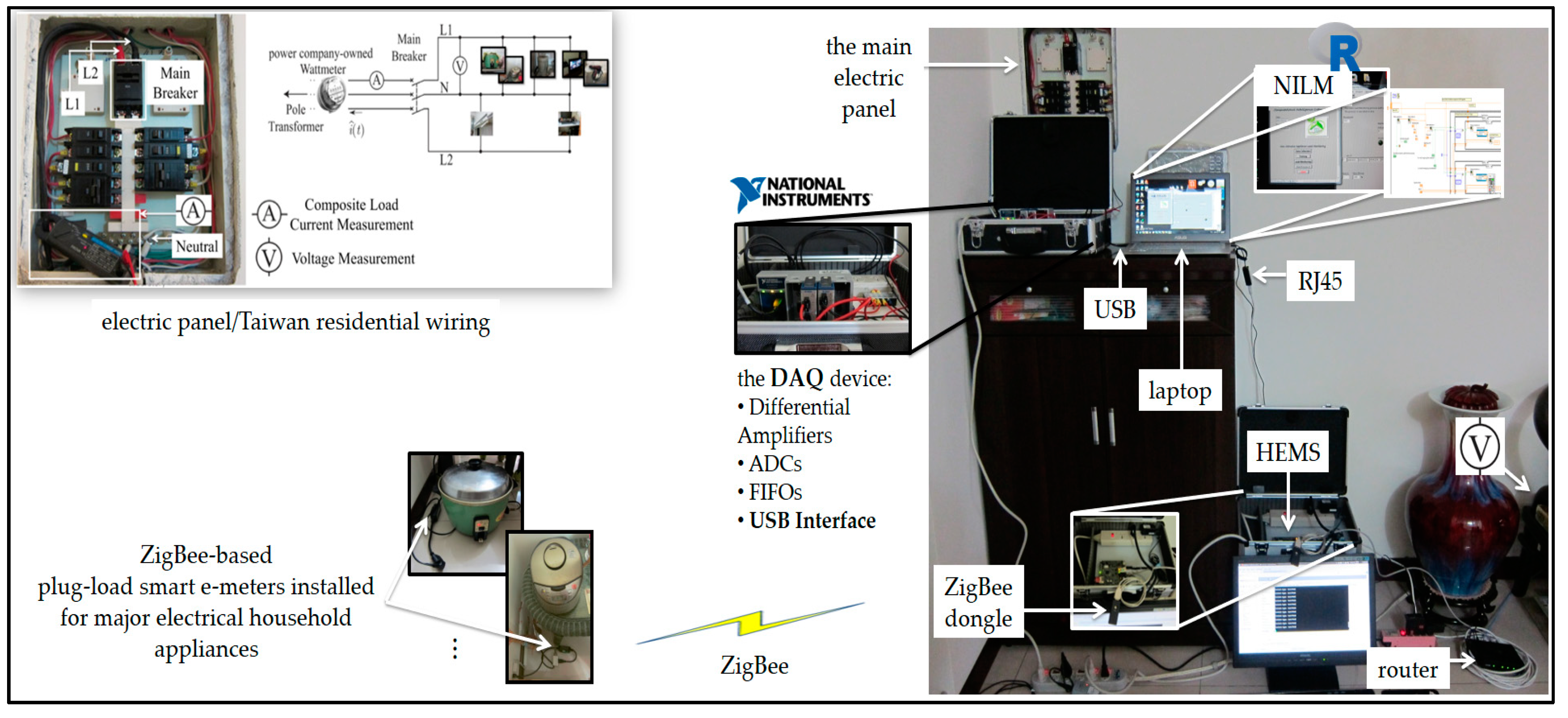
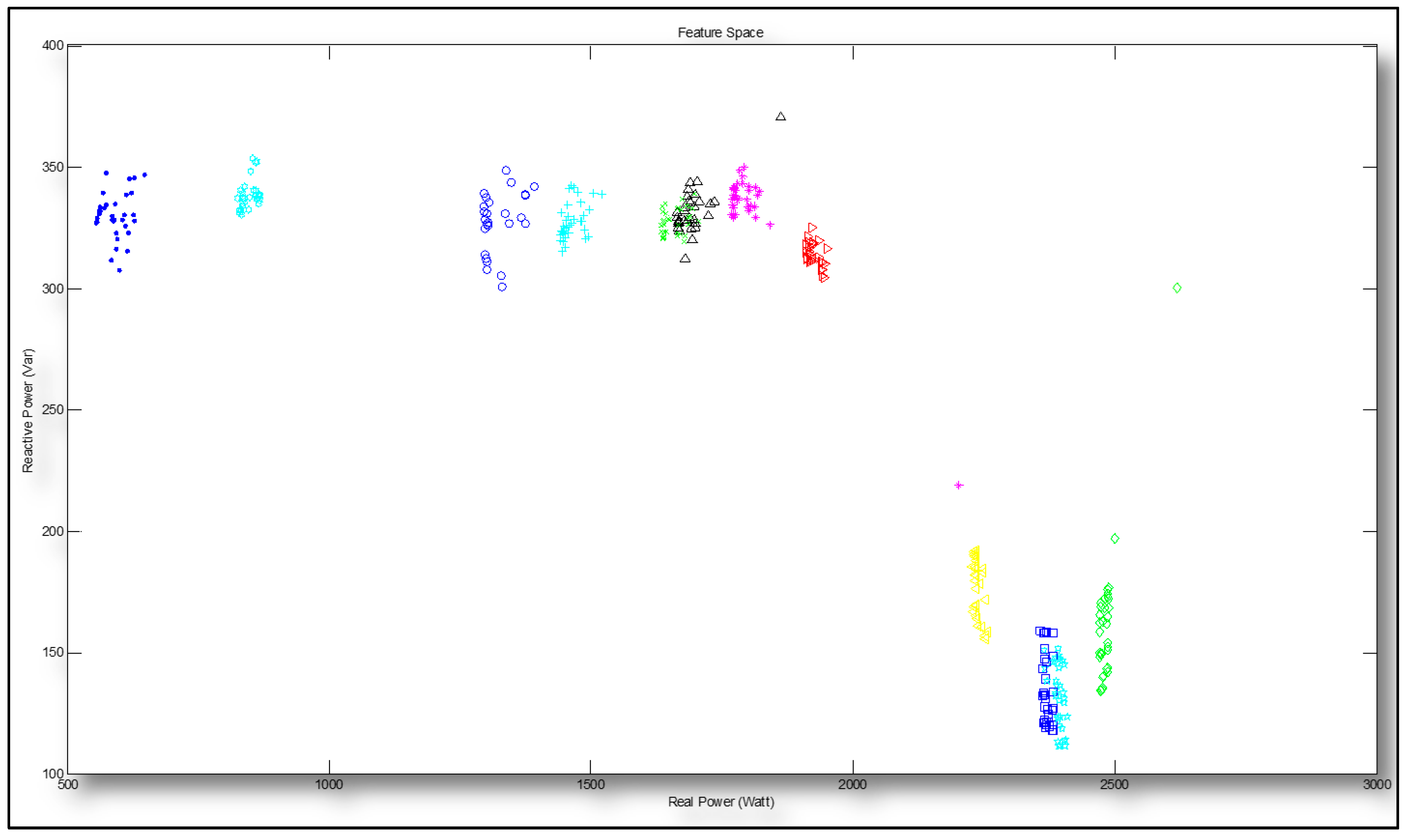

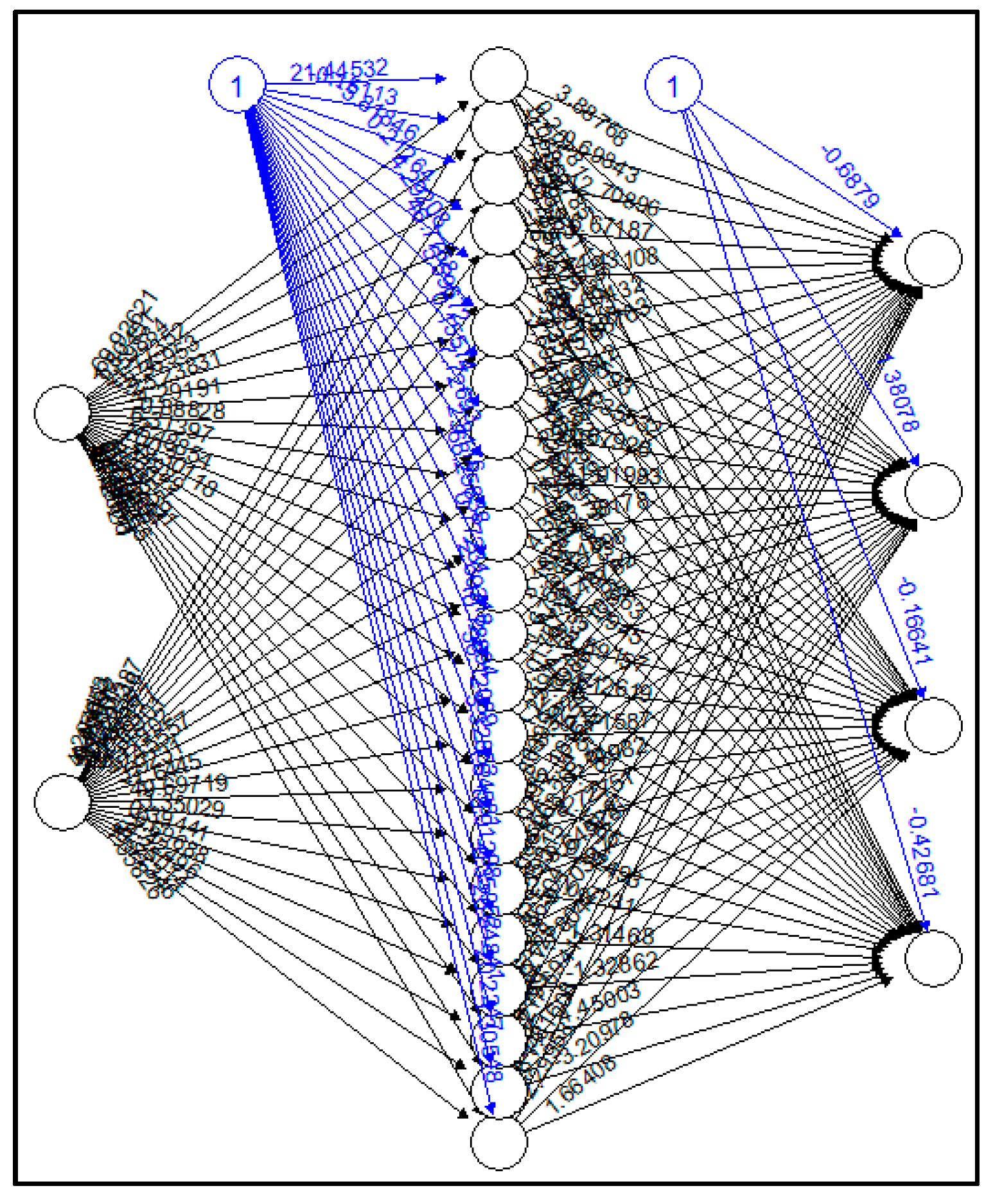
| For each particle Randomly Initialize the particle End |
| Do For each particle Compute its fitness value (the fitness function used for ANN design in Equation (8) and described in Section 2.2.3) If the fitness value is better than pbest in history, then Set the current value as the new pbest End Choose the particle with the best fitness value (against all the other particles in the population) as the gbest For each particle Compute its particle velocity, according to Equation (3) Update its particle position, according to Equation (7), where the binary PSO inspired in Reference [21] is conducted here as shown in Figure 6 End During the PSO process, the constraints of the fitness function in Equation (8) need to be satisfied While the pre-specified maximum iteration or the minimum error tolerance is not attained PSO was used in this paper to automatically and meta-heuristically design an ANN considering the three principal design factors; at the same time, all the constraints in Equation (8) were respected |
| Len1 | 221 |
|---|---|
| (wmin, wmax) | (0, 1) |
| (c1min, c1max) | (1.3, 4) |
| (c2min, c2max) | (1.3, 4) |
| Npop | 5500 |
| Iterationtmax | 50 |
| Maximum velocity | 25 |
| Range of weighting connections | (−25, 25) |
| Identification Results | Back Propagation (BP)-ANN | Hybrid ANN-PSO |
|---|---|---|
| Overall Classification Rate 1,2 in Training (%) | 85.34 | 93.53 |
| Overall Classification Rate in Tests (%) | 83.33 | 91.67 |
| Overall Classification Rate Improved (%) | - | 8.34 |
© 2018 by the authors. Licensee MDPI, Basel, Switzerland. This article is an open access article distributed under the terms and conditions of the Creative Commons Attribution (CC BY) license (http://creativecommons.org/licenses/by/4.0/).
Share and Cite
Lin, Y.-H.; Hu, Y.-C. Electrical Energy Management Based on a Hybrid Artificial Neural Network-Particle Swarm Optimization-Integrated Two-Stage Non-Intrusive Load Monitoring Process in Smart Homes. Processes 2018, 6, 236. https://doi.org/10.3390/pr6120236
Lin Y-H, Hu Y-C. Electrical Energy Management Based on a Hybrid Artificial Neural Network-Particle Swarm Optimization-Integrated Two-Stage Non-Intrusive Load Monitoring Process in Smart Homes. Processes. 2018; 6(12):236. https://doi.org/10.3390/pr6120236
Chicago/Turabian StyleLin, Yu-Hsiu, and Yu-Chen Hu. 2018. "Electrical Energy Management Based on a Hybrid Artificial Neural Network-Particle Swarm Optimization-Integrated Two-Stage Non-Intrusive Load Monitoring Process in Smart Homes" Processes 6, no. 12: 236. https://doi.org/10.3390/pr6120236
APA StyleLin, Y.-H., & Hu, Y.-C. (2018). Electrical Energy Management Based on a Hybrid Artificial Neural Network-Particle Swarm Optimization-Integrated Two-Stage Non-Intrusive Load Monitoring Process in Smart Homes. Processes, 6(12), 236. https://doi.org/10.3390/pr6120236






